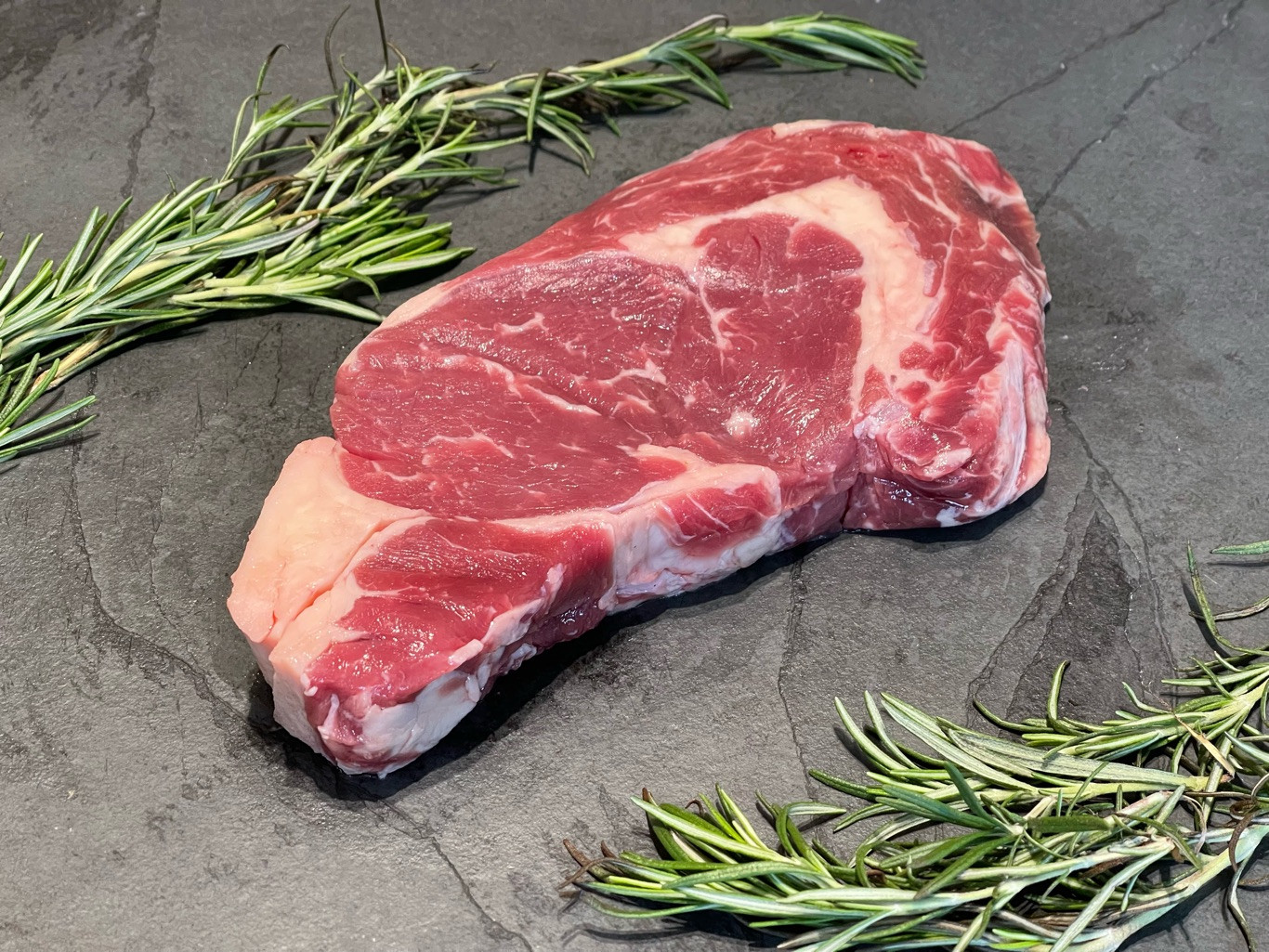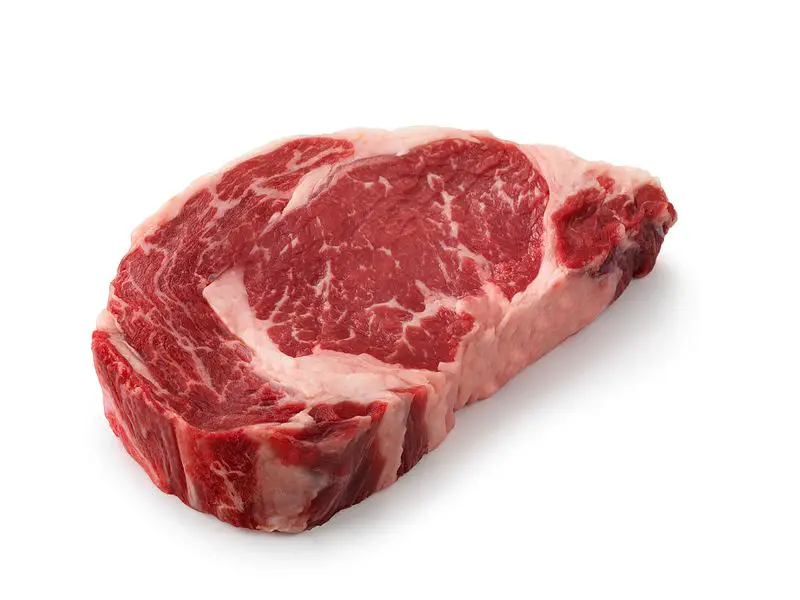Have you ever been to a steakhouse and had trouble deciding between the Delmonico vs ribeye steak? Both are delicious options, but depending on your appetite, budget and personal preference there may be advantages of one over the other.
In this blog post we’ll take a look at the differences between Delmonico vs ribeye steaks to help you decide which one is right for you. We’ll go over everything from taste and texture to cost so that by the end of reading this article you can pick out your favorite with confidence!
What Is Delmonico Steak?

Delmonico steak is a classic American cut of beef, named after the famous Delmonico’s restaurant in New York City. It typically comes from the ribeye section and is known for its robust beef flavor with generous marbling throughout. It tends to be very tender and juicy when cooked properly, making it a favorite among steak lovers.
What Is Ribeye Steak?

Ribeye steak is also known as Scotch Fillet or Entrecote. This cut of meat is taken from the rib section of the cow and has large streaks of fat running through it. Since it contains more fat than other cuts, this gives ribeye steaks their signature flavor and juiciness.
Delmonico vs Ribeye Nutrition
When it comes to nutrition, Delmonico and ribeye steaks are quite similar. Both contain a good amount of protein and vitamin B12. Delmonico is slightly higher in fat and saturated fat than ribeye, so if you’re looking for the leaner option then ribeye would be your best choice.
Differences Between Delmonico And Ribeye
The primary difference between these two steaks is the amount of fat. Delmonico has more fat marbling throughout, while ribeye typically has larger streaks of fat running through it. This usually means that ribeye steaks are juicier and have a more intense beefy flavor than delmonico steaks. Some people also prefer the texture of ribeye over delmonico because they find it to be more tender.
Taste & Texture
The taste between Delmonico vs Ribeye steak can also vary depending on personal preference. Many people find that the robust flavor of Delmonico combined with its marbling makes it their favorite cut while others prefer the juicy ribs of the Ribeye. In terms of texture, Delmonico steaks tend to be more tender due to the fact that they come from the ribeye section while ribeye steaks have a bit more chew to them due to the fat marbling.
Price
In terms of price, ribeye steaks tend to be slightly more expensive than Delmonico due to their higher amount of fat. However, both cuts are considered premium steak and will likely cost you a pretty penny per pound.
So which is right for you? It really depends on your personal preference when it comes to taste and texture as well as your budget. If you’re looking for something with a robust flavor and generous marbling then Delmonico steak should be your go-to choice. On the other hand, if you prefer juicier meat then the Ribeye could be the better option. Ultimately, it comes down to what fits best with your taste and budget.
Origin of the term
The term Delmonico steak is thought to have originated from the famous Delmonico’s restaurant in New York City. The exact origin of the term ribeye is unknown, though it was most likely derived from the name of the cut of beef which comes from the rib section.
Bones
Delmonico steaks do not contain any bones, while ribeye steaks will have a bone running through the center.
Marbling
Delmonico steaks have a generous amount of marbling which adds flavor and juiciness to the steak. Ribeye steaks also have some marbling but it tends to be more concentrated around the fat streaks.
Read more:
Similarities of Delmonico vs Ribeye
Delmonico and ribeye steaks both offer a delicious and juicy steak experience. Both cuts of meat come from the rib section, contain large amounts of fat, and have very similar nutrition profiles. They also share the same origin, being named after the famous Delmonico’s restaurant in New York City.
Whether you prefer the robust flavor of Delmonico or the juiciness of Ribeye, either one is sure to make for a mouthwatering meal. So go ahead and pick your fa-te with confidence!
Delmonico vs Ribeye Which One Tastes Better?
When it comes to taste and texture, the Delmonico steak is considered more tender and flavorful, while ribeye steaks tend to be juicier. The marbling in the Delmonico steak gives it a distinct beefy flavor that pairs well with bolder sauces or seasonings, while ribeyes have a milder flavor that’s great for grilling or smoking.
Delmonico vs Ribeye Which Is More Expensive?
It depends on where you shop, but generally speaking Delmonico steaks are more expensive than ribeye steaks. Because of its smaller size and lower fat content, Delmonicos cost more per pound compared to other cuts like ribeyes. However, if budget isn’t an issue, Delmonico steak is definitely worth the extra money.
Delmonico vs Ribeye Which Should You Choose?
When deciding between Delmonico vs ribeye steaks, it really comes down to personal preference. If you’re looking for an intense beef flavor, then go with the Delmonico steak. For a juicy and flavorful cut of meat, then ribeye steak is your best bet. Ultimately, both are delicious and make great additions to any meal!
Delmonico vs Ribeye Which Is Better?
It depends on your taste and budget when deciding between Delmonico vs ribeye steaks. Both cuts of beef offer delicious and juicy experiences that are sure to please.
If you’re looking for an intense flavor then go with the Delmonico steak, and if you want something more tender and juicy then choose the Ribeye. With either one, you won’t be disappointed!
How To Choose Delmonico vs Ribeye Steak
When it comes to choosing a steak, Delmonico and Ribeye are two of the most popular cuts. Both have their own characteristics and flavors that make them stand out in the world of steak.
Here’s what you should consider when deciding between Delmonico and Ribeye:
Texture: Delmonico steaks have a tender texture with fine-grained marbling, while Ribeyes are known for their juicy and robust flavor thanks to its thicker fat marbling.
Fat Content: Delmonicos contain less fat than ribeyes, which makes them leaner and healthier but also slightly less flavorful. If you want more flavor from your steak, the Ribeye is your best bet.
Price: Ribeye steaks tend to cost more than Delmonico cuts due to their higher fat content. However, if you’re looking for a leaner cut without sacrificing flavor, the Delmonico is usually the better option.
Cooking Time and Temperature: Delmonicos take longer to cook, so prepare for a longer cooking time when choosing this cut. On the other hand, Ribeyes can be cooked faster as they have more fat that helps keep them juicier and tender during cooking. Generally speaking, both should be cooked at medium-high temperatures (around 450°F).
In conclusion, deciding between Delmonico and Ribeye steaks will come down to personal preference in terms of flavor, texture and fat content. If you prefer a leaner cut with more tenderness, choose Delmonico; if you’re looking for a juicy and robust steak experience, go for Ribeye.
How To Cook Delmonico vs Ribeye
When it comes to cooking Delmonico and Ribeye steaks, there are a few key differences that you should consider.
For Delmonicos, cook them to an internal temperature of 130°F–135°F for medium-rare or 140°F for medium doneness. This cut takes longer to cook due to its leanness, so prepare accordingly.
Ribeyes can be cooked at slightly higher temperatures than Delmonicos—aim for an internal temperature of 135°F–140°F for medium-rare and 145°F for medium doneness. Because this steak is fattier than the Delmonico, it will take less time to cook and will retain more of its juiciness.
The best way to cook these steaks is by using a cast-iron skillet on the stovetop, then finished in the oven if desired. Remember to let your steak rest for at least 5 minutes after cooking to ensure that all of the juices are sealed in and it’s cooked to perfection.
Delmonico vs Ribeye: Cooking Tips & Suggestions
No matter which steak you choose, here are some tips for perfecting your Delmonico or Ribeye steak:
• Preheat the grill to medium-high before cooking.
• Use tongs to avoid puncturing the meat while turning it on the grill.
• Add butter, herbs and spices of your choice when finishing off the steak with a quick sear.
• Let steaks rest between 5–10 minutes after cooking to let the juices redistribute evenly throughout the cut.
• Slice against the grain for maximum tenderness.
Delmonico vs Ribeye Recipes:
• Grilled Delmonico Steak with Blue Cheese Butter
• Pan-Seared Ribeye Steaks with Shallot and Thyme Sauce
• Garlic Herb Roasted Delmonicos
• Pan-Fried Ribeyes with Mushroom Cream Sauce
FAQs:
Q: What’s the difference between Delmonico and Ribeye steaks?
A: The main differences between Delmonico and Ribeye steaks are in their texture, fat content, cooking time and price. Delmonicos have a tender texture with fine-grained marbling, whereas Ribeyes are known for their juicy and robust flavor thanks to its thicker fat marbling. Delmonicos contain less fat than ribeyes which makes them leaner and healthier but also slightly less flavorful. Ribeye steaks tend to cost more than Delmonico cuts due to their higher fat content. Additionally, Delmonicos take longer to cook than Ribeyes.
Q: How should I cook Delmonico vs Ribeye steaks?
A: When cooking Delmonicos, cook to an internal temperature of 130°F–135°F for medium-rare or 140°F for medium doneness. For Ribeyes, aim for an internal temperature of 135°F–140°F for medium-rare and 145°F for medium doneness. The best way to cook these steaks is by using a cast-iron skillet on the stovetop, then finished in the oven if desired. Remember to let your steak rest for at least 5 minutes after cooking to ensure that all of the juices are sealed in and it’s cooked to perfection.
Q: What recipes can I use with Delmonico and Ribeye steaks?
A: Some recipes that are perfect for Delmonico and Ribeye steaks include Grilled Delmonico Steak with Blue Cheese Butter, Pan-Seared Ribeye Steaks with Shallot and Thyme Sauce, Garlic Herb Roasted Delmonicos, and Pan-Fried Ribeyes with Mushroom Cream Sauce. These recipes will ensure that you get the most out of these two delicious cuts!
Q: What side dishes should I serve with Delmonico vs Ribeye steaks?
A: Side dishes that pair well with Delmonico and Ribeye steaks include roasted or mashed potatoes, creamed spinach, grilled veggies, caprese salad, and French fries. No matter what you choose to serve with these cuts of steak, it will be sure to please any crowd!
Q: How long do I need to let my steak rest?
A: Your steak should rest for at least 5 minutes after cooking in order for the juices to redistribute evenly throughout the cut. This will ensure a perfectly cooked steak every time!
Q: What cut is better than ribeye?
A: That depends on personal preference and what you’re looking for in a steak. If you like leaner cuts that are low in fat, then Delmonico steaks are the best choice. If you prefer robust flavor with juicy texture, then Ribeye is your best option. Ultimately, it all comes down to your specific tastes and preferences!
Q: Is there anything else I should keep in mind when cooking Delmonico vs Ribeye steaks?
A: Yes! Be sure to preheat the grill to medium-high before cooking and use tongs to avoid puncturing the meat while turning it on the grill. As always, let steaks rest between 5–10 minutes after cooking so that all of the juices are sealed in. Finally, be sure to slice against the grain for maximum tenderness. With these tips, you’ll be sure to cook the perfect Delmonico vs Ribeye steaks every time!
Q: What’s the best way to store steak?
A:When it comes to storing steak, it’s always best to wrap it tightly in plastic wrap or butcher paper and store it in the coldest part of your refrigerator (usually near the back). If you plan on freezing your steak, make sure that it is wrapped securely and then place into a freezer bag before freezing. Freezing will help extend its shelf life. When ready to eat, be sure to thaw overnight before cooking. Cooked steak should be consumed within 3 days if stored in the refrigerator.
Q: Is there any difference between Delmonico and Ribeye steaks nutritionally?
A:Yes, there is a difference in nutrition between Delmonico and Ribeye steaks. Ribeye steaks have more fat than Delmonicos, so they contain higher amounts of saturated fats. Additionally, due to its increased marbling, ribeyes also have slightly more calories. However, both cuts are still considered lean protein sources when served in appropriate portion sizes. It’s important to keep this in mind when considering nutritional value for your meals.
Q: How can I tell if my steak is done cooking?
A:The best way to tell if your steak is done cooking is by using a meat thermometer. As a general rule, steaks should be cooked until they reach an internal temperature of 145-degrees Fahrenheit for medium-rare doneness and 160-degrees Fahrenheit for medium doneness. Using a meat thermometer will ensure that you don’t overcook or undercook your steak. Additionally, you can also press the steak with your finger to feel how firm it is; a rare steak will feel soft while a well-done steak will be firmer to the touch.
Conclusion
Delmonico and Ribeye are two great cuts of steak. They are both tender and juicy, with a rich flavor that is sure to satisfy any steak lover. However, there are some key differences between these two types of steak. Delmonico steak is generally leaner than ribeye, and has a more delicate flavor. Ribeye, on the other hand, is richer and has more fat marbling throughout the meat.
This gives it a bolder flavor that can stand up to heartier toppings and sauces. So, which one should you choose? It all comes down to personal preference. If you want a Leaner steak with a more delicate flavor, go for Delmonico. But if you’re looking for a Richer, full-flavored steak, then Ribeye is the way to go.
Read more:
Beef Tenderloin vs Filet Mignon

James Burney is the founder of Acadia House Provisions is a restaurant that with local & upscale dishes and high-quality kitchen supplies and food products. James was born and raised in Maine, and he has always been passionate about cooking. After working in a number of prestigious restaurants he started Acadiahouseprovisions.com with the goal develop into a comprehensive information site specializing in cooking and cuisine. His goal is to make it easy for people to cook delicious meals at home without spending a fortune.
